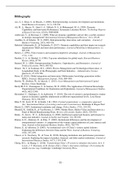Bibliography
Acs, Z. J., Desai, S., & Hessels, J. (2008). Entrepreneurship, economic development and institutions.
Small Business Economics, 31(1), 219-234.
Ali, M. A., Hussin, N., Abed, I. A., Nikkeh, N. S., & Mohammed, M. A. (2020). Dynamic
Capabilities and Innovation Performance: Systematic Literature Review. Technology Reports
of Kansai University, 62(10), 5989-6000.
Ambrosini, V., & Bowman, C. (2009). What are dynamic capabilities and are they a useful construct
in strategic management? International Journal of Management Reviews, 11(1), 29-49.
Anokhin, S., & Schulze , W. S. (2009). Entrepreneurship, innovation, and corruption. . Journal of
Business Venturing, 24(5), 465-476.
Babelytė-Labanauskė, K., & Nedzinska, Š. (2017). Dynamic capabilities and their impact on research
organizations' R&D and innovation performance. Journal of Modeling in Management, 12,
603-630.
Barney, J. (1991). Firm resources and sustained competitive advantage. Journal of Management,
17(1), 3-10.
Bartlett, G. A., & Ghoshal, S. (1986). Tap your subsidiaries for global reach. Harvard Business
Review, 64(6), 87-94.
Baumol, W. J. (1990). Entrepreneurship: Productive, Unproductive, and Destructive. Journal of
Political Economy, 94(5), 893-921.
Benner , M. J., & Tushman, M. L. (2002). Process Management and Technological Innovation: A
Longitudinal Study of the Photography and Paint Industries. . Administrative Science
Quarterly, 47, 676-706.
Berry, H. (2014). Global integration and innovation: Multicountry knowledge generation within
MNCs. Strategic Management Journal, 35(6), 869–890.
Bessler, W., Drobetz, W., & Adcock, C. (2013). Asset Management and International Capital
Markets. Oxon: Routledge.
Bierly III, P. E., Damanpour, F., & Santoro, M. D. (2009). The Application of External Knowledge:
Organizational Conditions for Exploration and Exploitation. Journal of Management Studies,
46(3), 0022-2380.
Biesenthal, C., Gudergan, S., & Ambrosini, V. (2019). The role of ostensive and performative routine
aspects in dynamic capability deployment at different organizational levels. Long Range
Planning, 52(3), 350-365.
Blau, P. M., Scott, W. R., & Smith, J. H. (1963). Formal organizations: a comparative approach
(Ser. International library of sociology and social reconstruction). Routledge & Kegan Paul.
Bleich, E. (2007). Institutional continuity and change. Policy Studies, 27(3), 219-234.
Blundell, R., Griffith, R., & Van Reenen, J. (1999). Market Share, Market Value and Innovation in a
Panel of British Manufacturing Firms. Review of Economic Studies, 66(3), 529-554.
Bontis , N., Keow , W. C., & Richardson, S. (2000). Intellectual capital and business performance in
malaysian industries. Joumal of lntellecrual Capital, 1(1), 85-100.
Bruton, G. D., Ahlstrom, D., & Puky, T. (2009). Institutional differences and the development of
entrepreneurial ventures: A comparison of the venture capital industries in Latin America and
Asia. Journal of International Business Studies, 40(5), 762-778.
Bruton, G., & Ahlstrom, D. (2003). An institutional view of China’s venture capital industry:
Explaining the differences between China and the West. Journal of Business Venturing,
18(2), 233–259.
Chacar, A. S., Newburry, W., & Vissa, B. (2010). Bringing institutions into performance persistence
research: Exploring the impact of product, financial, and labor market institutions. Journal of
International Business Studies, 41(7), 1119-1140.
Cheng, M. L., & Huang, C. (2016). Transforming China’s IP system to stimulate innovation. In A. Y.
Lewin, J. P. Murmann, & M. Kenney (Eds.), China’s innovation challenge: Overcoming the
middle-income trap. Cambridge: Cambridge University Press.
- 55 -




